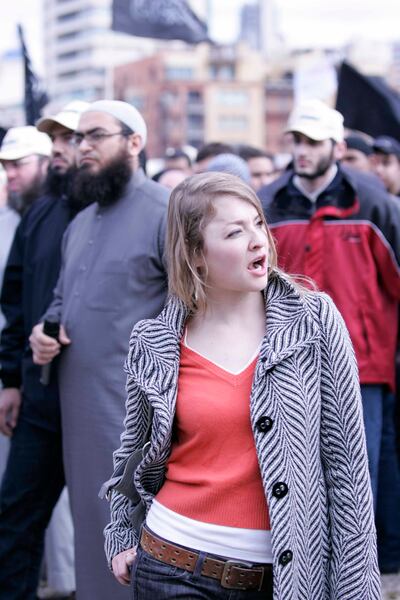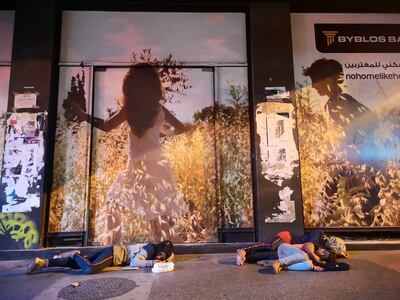Photojournalist Hussein Baydoun often takes pictures he shouldn’t.
Some of his images, which have gained widespread attention online, have got him into trouble. For example, his candid shot of Saad Al Hariri, former prime minster of Lebanon, biting his finger, caused him to be banned from that office for a month.
“I want to break taboos,” Baydoun tells The National. “In Lebanon, there are still subjects you don’t cross, but I want to play on them, show the different levels, the diversity in our society.”
With a career in photojournalism spanning more than a decade, Baydoun is now venturing into film. His first documentary, titled Before I Leave, centres on families who lost relatives in the Beirut port explosion last year.
“I’m trying to put my 15 years of experience into this documentary,” he says. Now in its editing stage, the film is expected to be completed by November.
In Baydoun’s photography, the complexity of Lebanese society can reveal itself in unexpected moments. Take an image of a young blonde waitress walking past a group of Salafists at an international conference – another one of Baydoun’s photos that did the rounds online – or his picture of a man and a woman exchanging pecks on the cheek as a woman in full niqab passes by.

In another, two female protesters, a generation or two apart, hold on to each other as nearby fires burn.
Other photographs demonstrate levity or beauty. In one of his more popular images, a flooded Beirut street is the site of tenderness as a man carries his partner in the pouring rain while she holds an umbrella over his head.
Baydoun, 34, started his career in news young. At 17, after completing a photography course, he took on photography jobs and started working full time at a newspaper two years later.
Even as a child he kept a close eye on the front pages. Baydoun was born in Germany to Lebanese parents who fled to the country during the Lebanese Civil War. He returned to Lebanon with his family when he was 10. Unable to speak Arabic, his grandmother would bring him the newspaper every day, helping him to read along. But it was the photographs that mostly caught his attention.
“I would remember the name of the photographer under the picture, and I would follow their work on the newspaper,” he recalls.
He has also completed projects for charities, including a photo book with the International Committee of the Red Cross.
His subjects range from defiant protesters during the Lebanese uprising of October 2019 to Syrian refugees escaping their own dire situations to enter into a country rife with them, and the families of Lebanese people who went missing during the Civil War and whose fates remain unknown.
Over the course of his career, Baydoun says he has learnt how Lebanon’s Civil War continues to inflict its wounds.
“We’re still at war, not with weapons, but with ideas,” he says. “To build a country, we need closure from the Civil War. A lot of people died, a lot of people are missing, but there has been no apology, no accountability.”
All this, Baydoun acknowledges, can weigh heavily on the psyche. “We have a lot of issues here in Lebanon, with women’s rights, human rights, refugee rights. It’s very hard … We’re seeing the hardest things in life. Sometimes I think I don’t want to bring any children into this world because of it,” he says.
Baydoun also turns his camera to the economic disparities evident on Beirut’s streets – homeless people asleep, with an aspirational advert for Byblos Bank as their backdrop.

“People run away from these things, but I run towards them,” he says. “You have to show people the truth.”
As Lebanon’s crises continue to deepen – fuel, water and medicine shortages, power outages, a crumbling currency and the ongoing trauma in the aftermath of the Beirut explosion – Baydoun knows he has work to do. Though the country’s difficult conditions are pushing some to leave, he is committed to staying.
“I have a disease. If I go outside of Lebanon for more than 10 days, I get sick, homesick,” he says.
During what was meant to be a week-long trip in October 2019, Baydoun flew back on the third day when he heard of the outbreak of the revolution. “As journalists, we’re making an archive of things that happen. It’s history,” he explains.
In the wake of the Beirut blast last year, despite injuries and damage to his home, he took to the streets to photograph the bloodied and shaken. That day, he says, he took more than 1,200 photos, of which only 20 have been published. The rest, some of which he deems too sensitive to be made public, now join his growing archive.
While his works have gained some attention, he is focused on the news as it comes.
“I’m always thinking about my next photo,” he says. Along with the thousands of images in his collection are the many varied and complex stories of Lebanon.





